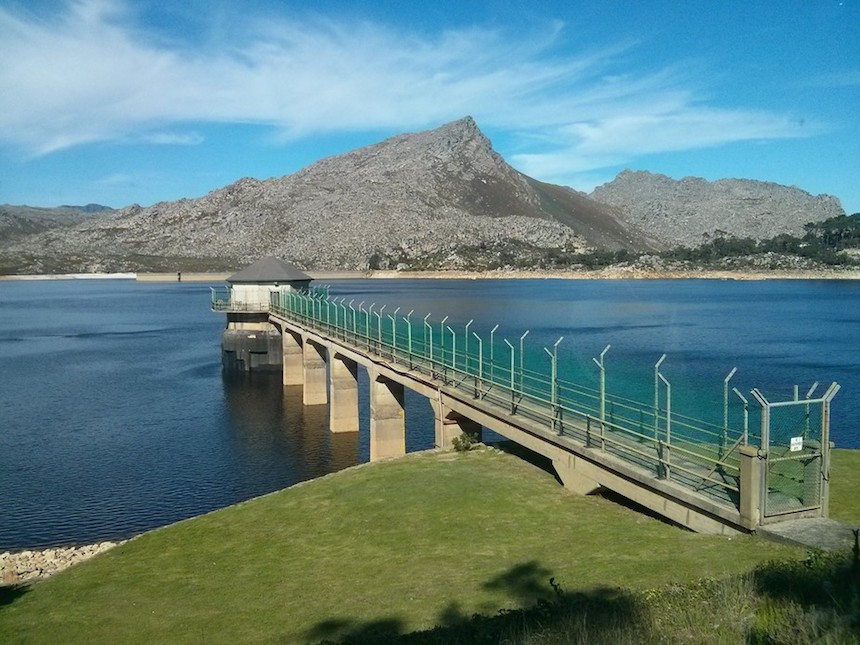
Cape Town, located in South Africa’s Western Cape, is facing one of its worst droughts in over a century. The city, and southern Africa more broadly, have been experiencing significant water shortages for the last two years that were not entirely unforeseen.
Since 2001, Cape Town has had a water conservation and demand management policy to reduce the city’s water demand. These efforts have kept overall water demand relatively stable until 2014, when demand started to rise. Due to a combination of lower rainfall in the winter of 2016 and a relatively slow initial governance response to the drought, the city officially declared a water crisis this year.
In early April, Cape Town was down to its last 100 days of water. The water levels in the dams that supply the city had fallen to 20% of their capacity. In response, the city imposed level four water restrictions. These include stricter limits on residential water use and strongly recommend a limit of 100 litres per person per day. They also include a ban on irrigation, and a 350 litres per day cap on the free basic water allocation for impoverished households, regardless of household size.
More recently, the Mayor of Cape Town announced the preparation of a new “Water Resilience plan” to address the future of the city’s water. The details of the plan have not yet been publicly announced, however the mayor highlighted that because of climate change, the city should shift towards water sensitive planning. This would involve:
managing all urban water (stormwater, groundwater, rivers and treated wastewater effluent) in an integrated way.
The city is considering stormwater harvesting and groundwater storage as potential longer term solutions. They have been shown to address drought risk and improve resilience.
Building resilience in the city’s water sector will also require addressing climate change, drought, and flooding in the winter seasons. Experts at the University of Cape Town have promoted the implementation of a Water Sensitive Urban Design that offers ways to build resilience to various risks. This approach involves various interventions at the city scale that use the water that flows through the city more efficiently. This includes focusing on sustainable management and use of stormwater. This approach has been successfully applied in others contexts, such as Australia.
Given that Cape Town is currently facing significant water shortages and can expect more frequent droughts in the future, the time is ripe for more carefully planned long term interventions.
Building a water resilient city
There is no established way to build resilience in the water sector, but a few ideas have been proposed.
- To build water-related resilience a city needs flexible institutions that can respond quickly and proactively to changes.
- Breaking down the silos that isolate water-related and other government departments, such as spatial planning and disaster risk management, community organisations and civil society, to facilitate more inclusive and informed planning.
- Making use of natural or green infrastructure in the water system which can serve as a natural buffer against water-related risks, such as flooding or drought.
Cape Town has already started considering stormwater harvesting, which has shown initial success. It involves collecting, treating and storing stormwater for potential reuse. It’s usually used for non-potable purposes or to replenish water in aquifers. But it has only been done on a very small scale in South Africa, limited to on site systems used for irrigation at factories or other businesses.
Research has shown that if treated stormwater is used for non-potable purposes -– such as irrigation and toilet flushing – it could reduce the total current residential potable water demand by more than 20%. This could be a significant water savings for the city. Of course, there are challenges associated with implementing reused stormwater, including water quality concerns and limited institutional capacity.
Successful stormwater management involves building or creating space for natural (green) ponds or corridors. These can absorb excess flood water, and prevent or reduce downstream flooding by slowing down the flow of stormwater through the city. They can also help replenish groundwater, either naturally, or through artificial recharge – the process of using stormwater to manually recharge groundwater aquifers. But natural detention ponds may also increase the vulnerability to flooding of informal settlements, if they are not carefully planned.
More importantly, building resilience in the water sector involves more than just technical solutions. It requires institutions that are able to respond proactively to early signs of stress, and to cater to the needs of diverse populations. Cape Town, like other African cities, has unique urbanisation challenges and persistent social justice issues that need to be considered in the transformation to a more water sensitive city.
Implementation should take into account Cape Town’s ongoing social inequality challenges. Research has already shown that the impact of disasters are not equally distributed. In dealing with the current water shortages and planning for the future, the city should consider carefully how the costs and benefits of building resilience in the water sector are distributed among different members of society.
![]() This article is based on a policy brief, co-authored with Emma Luker.
This article is based on a policy brief, co-authored with Emma Luker.
Lucy Rodina, PhD Candidate, University of British Columbia
This article was originally published on The Conversation. Read the original article.

